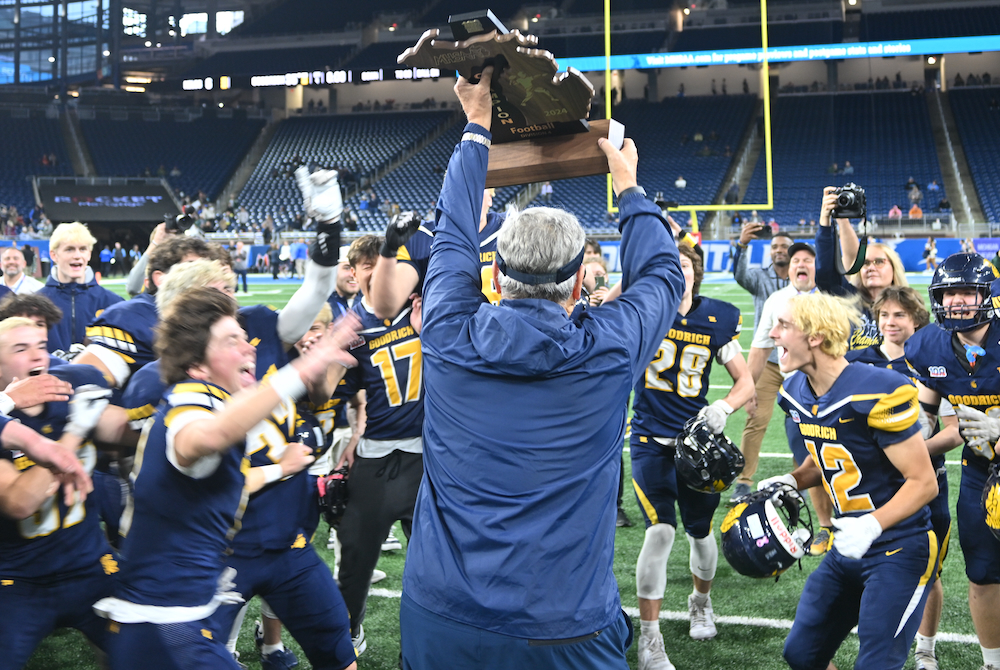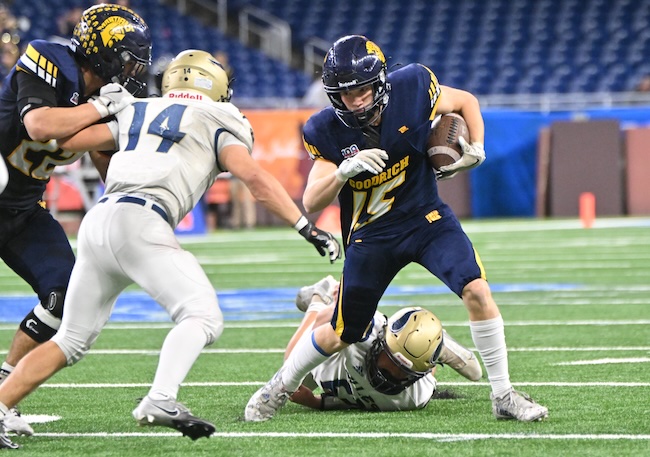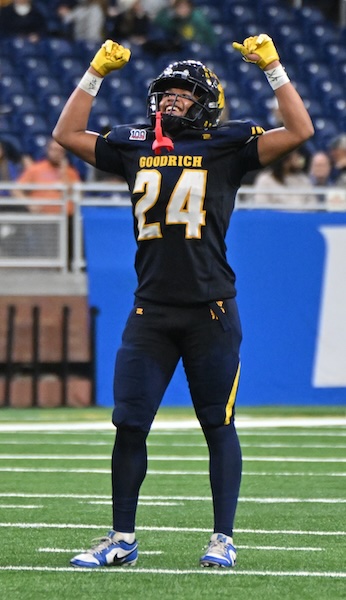
Inside Selection Sunday: Mapnalysis '15
October 26, 2015
By Geoff Kimmerly
Second Half editor
Consider that one hour Sunday night was the product of nine weeks of games on top of two more weeks of practice, hours of lifting weights, conditioning and camps and a total of six months of work at the MHSAA office, in addition to hours upon hours put in by athletic directors scheduling years in advance.
The anticipation for the release of another year's MHSAA Football Playoff pairings is matched by a giant exhale only after the results are broadcast on Fox Sports Detroit, streamed online and posted on locker room doors and Facebook walls all over our state.
 And then the fun begins again.
And then the fun begins again.
But the Selection Sunday Show is the favorite hour of the season for many fans across our state. And that’s why, for the fifth year, we’ll explain our most difficult decisions in this Mapnalysis 2015 breakdown of how we paired 272 teams that will play next month for championships across nine divisions.
For those familiar with our playoff selection process, or who have read this report in the past and don’t want a refresher on how we do what we do, skip the next section and go directly to the “Observations & Answers: 2015.” For the rest, what follows is an explanation of how we selected the playoff pairings during the morning hours Sunday, followed by how we made some of the toughest decisions and a few thoughts on the breakdown of the field.
Ground Rules
Our past: The MHSAA 11-player playoff structure – with 256 teams in eight divisions, and six wins equaling an automatic berth (or five wins for teams playing eight or fewer games) – debuted in 1999. An 8-player tournament was added in 2011, resulting in nine champions total each season.
The first playoffs were conducted in 1975 with four champions. Four more football classes were added in 1990 for a total of eight champions each fall. Through 1998, only 128 teams made the postseason, based on their playoff point averages within regions (four for each class) that were drawn before the beginning of the season. The drawing of Districts and Regionals after the end of the regular season did not begin until the most recent playoff expansion.
In early years of the current process, lines were drawn by hand. Dots representing qualifying schools were pasted on maps, one map for each division, and those maps were then covered by plastic sheets. Districts and Regionals literally were drawn with dry-erase markers.
Our present: After a late Saturday night tracking scores, we file in as the sun rises Sunday morning for a final round of gathering results we may still need (which can include making a few early a.m. calls to athletic directors). Re-checking and triple-checking of enrollments, what schools played in co-ops and opted to play as a higher class start a week in advance, and more numbers are crunched Sunday morning as the fields are set.
This season, there were a record-low 216 automatic qualifiers by win total – with the final 40 at-large then selected, by playoff-point average, one from each class in order (A, B, C, D) until the field was filled. There were only four Class D additional qualifiers with 5-4 or 4-4 (playing eight games) records from which we could choose – so after those four we added 12 teams each from Class A, Class B and Class C.
Those 256 11-player teams are then split into eight equal divisions based on enrollment, and their locations are marked on digital maps that are projected on wall-size screens and then discussed by nearly half of the MHSAA staff plus a representative from the Michigan High School Football Coaches Association. Only the locations themselves are marked (by yellow dots) – not records, playoff point averages or names of the schools or towns. In fact, mentions of those are strictly prohibited. Records and playoff points are not part of the criteria. Matchups, rivalries, previous playoff pairings, etc. also DO NOT come into play.
The same process is followed for organizing the 8-player bracket, with the difference that the 16 teams are selected purely on playoff-point average.
Geography rules: This long has been rule number one for drawing MHSAA brackets in any sport. Travel distance and ease DO come into play. Jumping on a major highway clearly is easier than driving across county-wide back roads, and that’s taken into consideration. Also, remember there’s only one Mackinac Bridge and hence only one way to cross between peninsulas – and boats are not considered a possible form of transportation. When opponents from both peninsulas will be in the same District, distance to the bridge is far more important than as the bird flies.
Tradition doesn’t reign: Every group of 32 dots is a new group – these 32 teams have not been placed in a bracket together before. How maps have been drawn in the past isn’t considered – it’s hard to say a division has been drawn in a certain way traditionally when this set of 32 teams is making up a division for the first time.
Observations & Answers: 2015
Go north with ease: For the most part, most Regional pairings were easier to draw than in past years. For the most part. Divisions 2 and 4 were not easy, specifically when it came to deciding which teams would be paired with an Upper Peninsula qualifier or a team from the Traverse City area. Keep in mind, distance on these maps isn’t based on how the bird flies, but how a bus would drive. In Division 2, that meant putting Muskegon, Muskegon Mona Shores and Grand Rapids Forest Hills Northern – near U.S. 31 and U.S. 131 – with Traverse City Central instead of sending Midland and Midland Dow west, up I-75 and then east-to-west again on more non-highway roads. In Division 4, we considered pairing Alma and Saginaw Swan Valley with Escanaba instead of Big Rapids and Remus Chippewa Hills. That decision came down to Big Rapids being about 14 miles closer to Escanaba than Swan Valley (Whitehall would go with Big Rapids and Chippewa Hills regardless.).
Four counties wide: Yes, on first glance it looks a little odd that Bay City John Glenn and Orchard Lake St. Mary’s would be in the same Division 3 District – but look at the map as a whole. Eight Division 3 teams are located south and mostly east of St. Mary’s, and John Glenn is the only team that could be considered in the northeastern quarter of the Lower Peninsula (Mount Pleasant and Gaylord are right down the middle and naturals to go with Sault Ste. Marie and Petoskey.). With the thumb playoff qualifiers of near-similar size in Division 4, there were no other options than to create this four-county trip between the Eaglets and Bobcats.
Semifinal selection: When all the Regional lines are drawn for a division, we also must figure out which Regionals will meet for Semifinals. This annually provides some challenges. Do we match east vs. west or north vs. south? If something seems iffy in four weeks when those games are played, again, keep in mind the entire map and entire Regionals that are matched up.
Scheduled strong: Because we’re looking only at dots on a map, we don’t see the matchups until everything is drawn – and in that way, we’re like everyone else. It wasn’t lost on us that two 9-0 teams will have road games this week or three 5-4 at-large qualifiers will be at home. For those 9-0 teams, it’s true: there’s nothing more they could’ve done on the field. But here’s why they will travel.
- Clinton, in Division 6, hasn’t lost a regular-season game since 2011, and in fact plays in a strong Tri-County Conference made up of Class C schools and one Class D. Four of eight from the league made the playoffs, and the competition was so strong that Morenci and Petersburg-Summerfield will host games in Division 8. But Clinton’s opponent, Monroe St. Mary Catholic Central, while it did have one loss, fell to one-loss Class B Lansing Catholic – and the Falcons played eight Class B and one Class A school this season. Beating a Class B team is worth 16 points more than beating a Class C and 32 more than beating a Class D (with those points then divided over the number of games a team plays that season) – and all of that made the difference in St. Mary’s final eight-point playoff average edge over Clinton.
- Saugatuck in Division 7 is a similar story. The Indians are one of three undefeated teams in their District, and did play a pair of Class B opponents. But by no fault of their own, especially in league play where the schedule is set, Saugatuck didn’t face a team this season that won more than five games. Hesperia played three Class B opponents including one that finished 6-3 – enough for the slim 1.8 points more in playoff average that earned the Panthers homefield advantage. Pewamo-Westphalia has the highest average in the District and didn’t play a Class B – the Pirates actually played three Class D teams. But they also beat four teams that made the playoffs including two that finished 8-1 – giving them a 2.7-point edge on Hesperia and 4.5 edge on Saugatuck.
- The 5-4 teams that will host – Redford Thurston in Division 3 and Escanaba and Benton Harbor in Division 4, all earned their spots. Escanaba faced six playoff teams and beat three, Class B Benton Harbor played eight Class A teams, and Thurston played five playoff teams and a sixth that just missed an at-large bid.
At the end of the day ...
What you see is what our committee decided upon after multiple discussions among multiple groups that broke down every sensible possibility we could muster. There are certainly points open to argument – and we likely made those arguments as well.
Those who would like to see the playoff selection process changed are in favor of a larger strength-of-schedule component, and it’s interesting to see how strength of schedule inadvertently made a larger impact this season than in the recent past – especially given the examples above of undefeated teams going on the road and at-large teams hosting.
Why were there fewer automatic qualifiers than ever before? Here's one theory. There were 11 fewer teams in 11-player football this season than in 2014 (most moved to 8-player). An argument can be made that there were fewer wins to be gained against teams that last season might have struggled to field 11-player teams, shifting the balance to fewer automatic qualifiers and more parity with stronger teams facing each other to fill their schedules.
Meanwhile, the 8-player field grew by nine teams this fall and has its strongest ever, with seven teams that finished 5-4 missing the postseason after a team with a sub-.500 record got in just a year ago.
Given how some matchups shook out this fall, the next argument by those seeking change likely will center on seeding entire Regionals instead of just Districts. But keep this in mind as well: if Regionals were seeded with this year's groupings, it would create possibilities of first-week trips like Battle Creek to Traverse City and Cedar Springs to Sault Ste. Marie. We're fairly sure most coaches and players would dread such journeys for a first-round game.
It's a lot to digest, and the scrutinizing will surely continue long after these playoffs are done as we all work to conduct the best tournament possible.
But at the end of the day – and the end of these next five weeks – to be the best, teams will need to beat the best no matter the matchups. And we’ve got plenty to look forward to starting this weekend and all the way through the 11-player Division 3 Final on Nov. 28 at Ford Field.
The MHSAA Football Playoffs are sponsored by the Michigan National Guard.
PHOTO: The Division 4 map was among the most difficult to draw during this year's selection process.

Playing 'Goodrich Football' at its Finest, Martians Make Title Dream Come True
By
Brad Emons
Special for MHSAA.com
November 29, 2024
DETROIT – Over his 32 years as head football coach at Goodrich, Tom Alward had come close once but was never able to hoist a state championship trophy.
But that all ended Friday as his Martians invaded Ford Field and rolled to a 35-6 victory over Niles in the Division 4 Final.
After falling 22-0 to Grand Rapids South Christian in the 2022 D4 championship game, Goodrich put on an impressive display in all three phases – offense, defense and special teams – to finish a 13-1 season and earn its first Finals title.
“I never gave up on a dream, and these guys are the ones that made it come true,” Alward said. “We tell the guys we want to get better every year. And I’ve had 32 of them get better. It’s been a great ride.”
To show how dominant the Martians were, Goodrich outgained the Vikings 424-96 in total yards.
And it all started up front.
 “That’s Goodrich football,” Alward said. “That’s the way we play, that’s the way we coach it and we teach it, and what these guys bought into. We need to own the line of scrimmage on both sides of the ball, and when we do, good things happen.”
“That’s Goodrich football,” Alward said. “That’s the way we play, that’s the way we coach it and we teach it, and what these guys bought into. We need to own the line of scrimmage on both sides of the ball, and when we do, good things happen.”
Goodrich showed great balance offensively as junior quarterback Tanner Mazich was 6 of 9 passing for 168 yards and a touchdown, while senior running back Chase Burnett rushed for 157 yards on 28 carries and a pair of TDs. Junior Jakoby Lagat contributed 76 yards on 12 carries along with another TD run.
It was all Goodrich in the opening half – and then some.
The Martians took a 7-0 lead with a 10-play, 68-yard drive resulting in a Mazich 21-yard TD strike to senior Max Macklem with 4:38 to go in the first period.
“It’s amazing when you have five or seconds to get open,” Macklem said. “He just gives me time back there. I find open grass and just throw the ball.”
Burnett then scored on a 1-yard TD run with 9:49 remaining in the second quarter as the Martians marched 74 yards on 11 plays to make it 14-0.
“I just always follow my blockers,” said the 6-foot, 200-pound Burnett. “I’m not going to go down with one tackle. I’m going to bounce off them, keep following them and run through tackles.”
Goodrich’s Zaiden Hall then came up with an interception at his own 49 with 6:27 to go in the half to set up Burnett’s six-yard TD run just 78 seconds later for a 21-0 advantage following Landon Williams’ third straight PAT. (A 41-yard pass from Mazich to Macklem set up the score).
“We liked the matchups with Max (Macklem) and we took shots, and that’s what happened – it worked,” Mazich said.
Goodrich was poised to go up four scores at the end of the half as Mazich hit Lagat on a 34-yard pass to put the ball on the Vikings’ 11.
But the Martians – out of timeouts – couldn’t spike the ball in time before the half ended following a five-yard run by Burnett down to the Niles 1 as the score remained 21-0.
The Vikings, making their first Finals appearance, had only 34 yards of first-half offense while Mazich himself was 4 of 5 passing for 130.
Goodrich got the ball to start the second half, and the Martians used 7:50 to score on a 16-play, 73-yard drive culminating in a Colton Burnett one-yard TD run to go up by 28 points. On the first play of the fourth quarter, Lagat scored a 12-yard run as the Martians pushed the lead to 35.
 Niles, a winner of 12 straight after losing its season opener 30-7 to St. Joseph, couldn’t find any bargains offensively against the Martians’ suffocating defense. If there was any consolation for the Vikings, it came with 1:02 remaining when Peyton Gordon rushed 35 yards for the game’s final score.
Niles, a winner of 12 straight after losing its season opener 30-7 to St. Joseph, couldn’t find any bargains offensively against the Martians’ suffocating defense. If there was any consolation for the Vikings, it came with 1:02 remaining when Peyton Gordon rushed 35 yards for the game’s final score.
Meanwhile, with his ability to make throws on the run and extend plays, Mazich proved to be a major thorn in Niles’ side.
“We had a great season. I’m proud of these guys,” Niles fourth-year coach Scot Shaw said. “They (Goodrich) are good; they obviously have to be to be here. (Mazich) did what he did and did well. We couldn’t stay in front of receivers, and we couldn’t have an edge on that kid. They controlled both lines of scrimmage, and they’re well-coached, played hard. I don’t know if we got caught by surprise ... take nothing away from them, but we didn’t play real well. But that’s part of it. Probably because they played better than we did.”
Shaw said Goodrich’s team speed was somewhat deceiving.
“They’re quick,” he said. “They probably didn’t look that quick on film. Their alignment really didn’t surprise us because they had shown that, but I think they were stronger and faster than probably we gave them credit for.”
Goodrich’s first championship run began during the offseason.
“I believed in these guys all season; they’re an incredible group,” Alward said. “They started workouts at 5:30 in the morning on January 8 of this year. And these guys, along with many others, didn’t miss workouts. They’ve worked that hard to get to this point. They deserve all the success that they have achieved. I can’t tell you how proud I am of them, how physical they play and just how much they embrace what we’re trying to do. And that’s gotten us to where we are right now.”
It was only two years ago when Mazich, then a freshman, was serving as a scout team quarterback during the Martians’ 2022 tournament run.
“I got to experience it,” the 5-foot-10, 165-pound junior said. “I just remember how disappointed everyone was with the loss and obviously we got our butts kicked pretty good, but I think it helped us win this game today. They came out strong and owned us the whole game, and that’s what we had to do this game and we did. Obviously Max Macklem is a great receiver, and we have three great running backs. It’s kind of hard to stop the offense with a bunch of weapons like that.”
PHOTOS (Top) Goodrich football coach Tom Alward hoists his football program’s first championship trophy as players rush to him Saturday at Ford Field. (Middle) The Martians’ Thomas Niles (15) works to pull away from a Niles defender. (Below) Jakoby Lagatt (24) enjoys a replay on the scoreboard. (Photos by Hockey Weekly Action Photos.)

